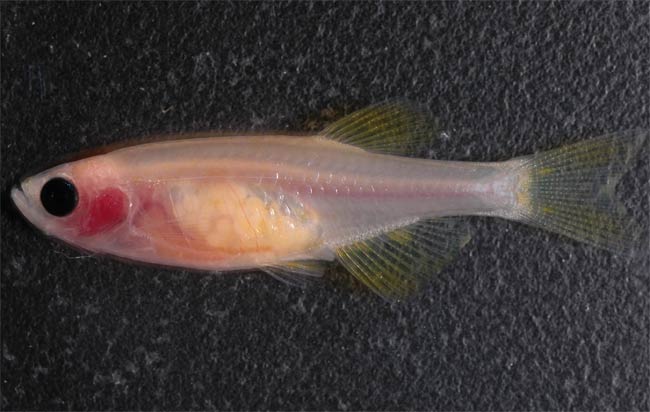Scientists Create See-Through Fish, Watch Cancer Grow

A newly bred fish bares all in the lab, revealing brain, heart and other internal organs in the name of research.
Scientists are breeding zebrafish with see-through bodies in order to make studying disease processes easier, including the spread of cancer.
The transparent fish, described in the Feb. 7 issue of the journal Cell Stem Cell, are allowing researchers at Children's Hospital Boston to directly view fish's internal organs and observe processes such as tumor growth in real-time in living organisms. Scientists previously studied disease in the embryos of zebrafish, which are naturally transparent. But their clear bodies turn opaque when they grow into adults. The newly created zebrafish stays transparent throughout its lifetime.
"Everything after four weeks has been invisible to us," said study team member Richard White, a clinical fellow in the Stem Cell Program at Children's Hospital Boston.
Zebrafish are genetically similar to humans in many ways and serve as good models for human biology and disease.
Traditionally, researchers have relied on information collected after the diseased animal died to infer anything about human ailments. But for rapidly changing processes such as cancer, this snapshot method is bound to miss something. "It's like taking a photograph when you need a video," said White, also an instructor of medicine at the Dana-Farber Cancer Institute in Boston.
Fish exposed
Get the world’s most fascinating discoveries delivered straight to your inbox.
White created the transparent fish, which he nicknamed Casper, by mating two existing zebrafish breeds, one that lacked a reflective skin pigment and the other without black pigment. The offspring had only yellow skin pigment, essentially appearing clear.
In one experiment, White and his colleagues inserted a fluorescent melanoma tumor into the abdominal cavity of the transparent fish. By observing the fish under a microscope, they found that the cancer cells started spreading within five days. White could actually see individual cells spreading.
"The process by which a tumor goes from being localized to widespread and ultimately fatal is the most vexing problem that oncologists face," White said. "We don't know why cancer cells decide to move away from their primary site to other parts in the body."
The spreading melanoma cells appeared to flock toward the skin after leaving the abdominal cavity. "This told us that when tumor cells spread to other parts in the body, they don't do it randomly," White said. "They know where to go."
Stem cells
White ran a similar experiment in which he transplanted fluorescent blood-forming stem cells from another zebrafish into a transparent one. By four weeks, the stem cells had visibly moved into the see-through fish's bone marrow and started growing.
Marrow, the soft fatty tissue inside bones, supports stem cells that each ultimately become a type of blood cell, which gets released into the bloodstream. Any disease that disrupts the production of mature blood cells or their precursors can cause a bone marrow disorder, such as leukemia.
While transplants of blood-forming stem cells help cancer patients rebuild healthy blood, for unknown reasons some transplants don't "take." If researchers could understand the step-by-step process in which the stem cells embed and build blood in the fish, they could figure out ways to help patients rebuild their blood faster.
- Vote for the Freakiest Lab Animals
- Top 10 Mysterious Diseases
- Images: Freaky Fish
Jeanna Bryner is managing editor of Scientific American. Previously she was editor in chief of Live Science and, prior to that, an editor at Scholastic's Science World magazine. Bryner has an English degree from Salisbury University, a master's degree in biogeochemistry and environmental sciences from the University of Maryland and a graduate science journalism degree from New York University. She has worked as a biologist in Florida, where she monitored wetlands and did field surveys for endangered species, including the gorgeous Florida Scrub Jay. She also received an ocean sciences journalism fellowship from the Woods Hole Oceanographic Institution. She is a firm believer that science is for everyone and that just about everything can be viewed through the lens of science.


